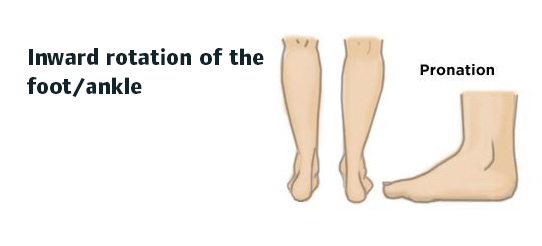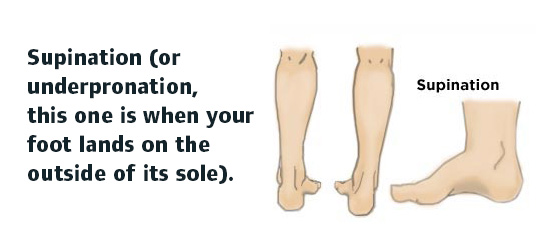
Do your feet pronate? (inward rotation of the foot/ankle)
If the foot pronates then pronation will be an underlying factor to many of the conditions below and so you will need to identify and treat with orthotics to realign and control the rearfoot and support the longitudinal arch. Pronation is when your foot rolls more than 15 degrees inward causing pressure to your lower legs. It happens to people with lower arches. Never use a single orthotic, always wear a pair as this will maintain correct foundational balance.
 Are you suffering from supination?
Are you suffering from supination?
If you notice excessive wear on the outside of your shoes, you may be guilty of supination. Supination (or underpronation, this one is when your foot lands on the outside of its sole.) Supination effects people with higher arches, who will experience jarring in the foot and to the upper structure, and will usually have a rigid high arched foot type.

The common conditions that an orthotic and shoe insole can treat include:
• Bunions – usually caused by a short 1st metatarsal and aggravated by pronation.
• Ball of Foot Pain – collapsing and rotating of the metatarsals caused by pronation.
• Plantar Fasciitis / Heel Spur – pronation causes the fascia to elongate and tear from the calcaneus. Spurs are a secondary compensation.
• Severs Disease (children’s heel pain) – related to pronation and growth spurts in children and affects sporting children more than sedentary ones.
• Achilles Tendonitis – constant bending of the Achilles tendon caused by both pronation and supination creates a point of pain stress point. • Shin Splints – lateral/medial/ anterior pronation and supination are the key contributing factors.
• Knee Pain – collateral ligamental strain due to pronatory and supinatory factors.
• Hip Pain – due to structural or functional leg length and supinatory factors including tight external hip rotators and long leg jamming action.
• Low Back Pain – Unilateral and bilateral pronation, and structural and functional leg length causing stress on the lower back L1-L5.
• Leg Length Syndrome – when a structural leg length difference is evident the long leg may excessively pronate to level the pelvis and so the orthotic will correct the long leg pronation and a heel lift will be added to the orthotic on the short leg.
Who will benefit from Arch Supports and Orthotics?
Orthotics and Arch Supports benefit people who walk or stand excessively at their work and those who are active in sports, by increasing endurance, performance and strength. People who are overweight, diabetics and the elderly can also benefit as these individuals need accommodation or increased softness to relieve pressure on the foot.
How Orthotics and Shoe insoles work
Both devices distribute the force of impact on the feet over a greater area. In this way the pressures acting on the bottom of the feet are redistributed and thus provide relief to sensitive or painful areas.
Arch support and shoe insoles are both used to give added support to the arches and they can control the amount and the rate of foot motion – especially pronation. This works by identifying the neutral position where the foot is neither pronated nor supinated, that is, neither on the outer edge nor the inner edge of the sole bears the body‘s weight.
How to wear:
Orthotics and Shoe Insoles require a period of adjustment so you should wear them for 1-2 hours per day, increasing gradually until your comfortable wearing them full time. A shoe orthotic or shoe insole can be misused if the device limits foot motion too much, or it fails to limit motion enough. Given that the total range of motion for pronation and supination available in the foot is relatively small (roughly 15°) it is more likely the shoe insert will limit motion too much leading to pain.
If you experience discomfort, then you should take the orthotics out of your shoes, and give your feet a rest. Then resume wearing the orthotics. Continue until the your comfortable wearing the orthotics all day.
Come tell me the way you pronate! Do you supinate, overpronate or are you perfect?


Leave a Reply